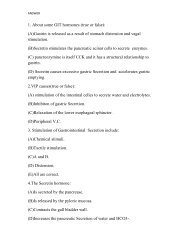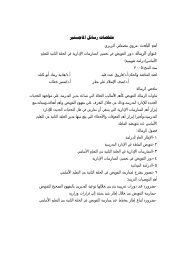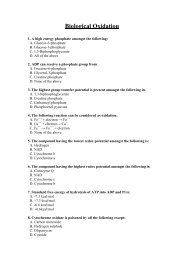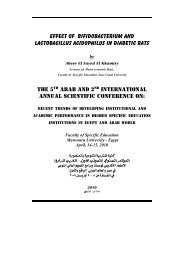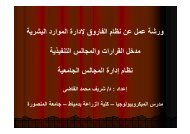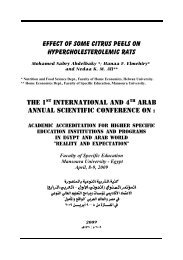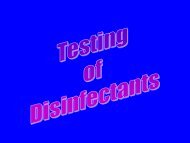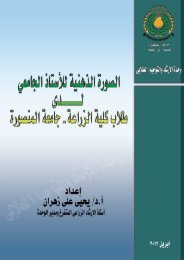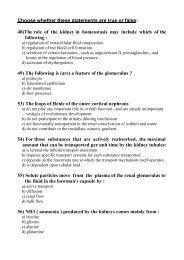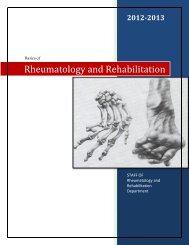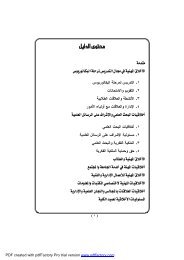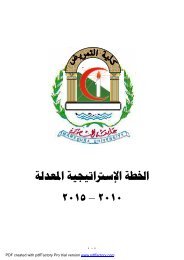Mycology Samples
Mycology Samples
Mycology Samples
Create successful ePaper yourself
Turn your PDF publications into a flip-book with our unique Google optimized e-Paper software.
Collection, transport &<br />
Processing Of <strong>Mycology</strong><br />
<strong>Samples</strong><br />
Eman Elmansoury
Laboratory Diagnosis<br />
1. Mycological Diagnosis<br />
a. Sampling<br />
b. Direct microscopical examination.<br />
c. Cluture.<br />
d. Identification.<br />
2. Histopathological Diagnosis<br />
Special fungal stains i.e. PAS and GMS.<br />
3. Serological Diagnosis.<br />
4. Molecular diagnosis.
When to Suspect Fungal<br />
Infections?<br />
• Persistent illness, despite appropriate antibacterial<br />
therapy.<br />
• Premature infants, oncology patients who become<br />
neutro-penic and other intensive care patients with<br />
indwelling central catheters.
For successful isolation consider:<br />
•Patient request<br />
•Patient information (labeling)<br />
•Proper collection<br />
•Proper transport<br />
•Correct processing<br />
•Inoculation of sample on proper<br />
culture media
Criteria for specimen rejection<br />
1. Absence of patient identification or discrepancy<br />
between the information on request form and<br />
sample label<br />
Action: Return for resoltion<br />
2. Sputum with squamous cell >25 cell/ low power field<br />
Action:<br />
Pathogenic fungi maybe recovered in presence of<br />
oral contamination if antibiotic containing<br />
selective media is used<br />
Final report should indicate presence off oral<br />
contamination
Criteria for specimen rejection<br />
3. Sample with inadequate volume or<br />
Action: Order 2 nd sample<br />
4. Dried out swab (if wet)<br />
Action:(Swaps not suitable for recovery of fungi &<br />
should be rejected…deep aspirtion or biobsy better)
Criteria for specimen rejection<br />
5. sample in improper container or unsuitable<br />
conditions (drying, leakage, lack of sterility)<br />
Action: If 2 nd specimen couldn’t be obtained<br />
process final report: specimen was compromised<br />
& result interpreted in light of clinical<br />
presentation<br />
6. 24 hour urine or sputum for fungal culture<br />
chance of contmination with bacteria &<br />
invironmental molds<br />
Action: Another sample
Generally<br />
• <strong>Samples</strong> examined as soon as possible<br />
• Specimens not processed immediately held at<br />
room temerature, refrigerated, freezing unacceptble.<br />
• If there is delay in processing,To prevent growh of<br />
commensal bacteria in nonsterile specimens add:<br />
◦ 20 IU/ml penicillin,<br />
◦ 10 mg/ml streptomycin or<br />
◦ 0.2 mg/ml chloramphenicol
1. Sputum<br />
Collection & Transport:<br />
◦ 1st early morning sample before breakfast<br />
◦ rinse mouth with water<br />
◦ 5 ml in screw capped sterile container<br />
◦ If inadequate → use aerosol saline suspension by<br />
heating
1. Sputum<br />
Lower Respiratory Tract <strong>Samples</strong>:<br />
•Lung biopsy<br />
•Brushing<br />
•Bronchoalveolar lavage<br />
→ in sterile sealed container
1. Sputum<br />
Processing:<br />
•select most purulent or bloody part<br />
of sample<br />
•if viscid → homogenized by adding<br />
N-acetyl L-cystein & Avoid NaOH<br />
which give alkaline pH for culture<br />
media
1. Sputum<br />
microscopic examination KOH mount<br />
culture: inoculate 0.5 ml to each culture<br />
media which contain antibiotic to inhibit<br />
bacteria flora in sputum e.g. IMA & BHI<br />
with chloramphenicol + cycloheximide
2. C.S.F.<br />
Collection & Transport:<br />
◦ By lumbar puncture in sterile container<br />
(number 3 tube) to avoid skin flora<br />
◦ if delay is suspected → do not<br />
refrigerate<br />
◦ left in room temperature as CSF itself is<br />
considered as adequate culture media<br />
for fungal elements
2. C.S.F.<br />
processing:<br />
• < 2 ml → direct culture<br />
◦3-5 drops on tube media or<br />
◦2-3 drops …… ½ ml on plate culture media<br />
• > 2 ml → concentration<br />
◦ Centrifuge for 5 minutes at 2000 rpm<br />
◦ Remove supernatant fluid by sterile pipette for<br />
cryptococcal antigen testing
2. C.S.F.<br />
◦ Direct examination<br />
use 1 drop of the sediment to make an<br />
India ink mount if Cryptococcus is<br />
suspected<br />
◦ Culture:<br />
Re-suspend sediment in 1-2 ml of CSF &<br />
inoculate onto IMA or SABHI
2. C.S.F.
3. Urine<br />
Collection & Transport:<br />
• Volume: 2 - 5 ml<br />
• 1st early morning sample on 3 successive days (fungi tend to<br />
be shed at intermittent intervals)<br />
• Random sample is accepted<br />
• Sample is collected aseptically in sterile screw capped<br />
container and sent immediately to lab.<br />
• If delay → refrigerated at 4° C to inhibit growth of rapidly<br />
growing bacteria
3. Urine<br />
Processing:<br />
◦ centrifuge at 2000 rpm for 5 minutes<br />
sediment.
3. Urine<br />
Direct examination<br />
◦ Prepare a direct smear of the sediment in KOH<br />
for direct microscopy<br />
Culture:<br />
◦ inoculate ½ ml sediment to both IMA & BHI with<br />
chloramphenicol + Cycloheximide
4. Prostatic secretion<br />
• 1st empty the bladder<br />
• Do prostatic massage<br />
• Inoculate secretion directly on proper fungal media<br />
• Collect 5 – 10 ml (1 st voided) urine in separate<br />
container after prostatic massage
5. Exudates<br />
Collection & Transport:<br />
• 1st disinfect the skin by iodine & ethyl alcohol 70 %<br />
• Aspirate by sterile syringe which serve as transport<br />
container<br />
Processing:<br />
• if > 2 ml → concentrate → sediment → direct examination &<br />
1/2 ml for culture<br />
• if > 2 ml with clot → inoculate clot onto culture media<br />
• if < 2 ml with clot → mince with scalpel → inoculate whole<br />
sample on culture media
6. Biopsy<br />
Collection & Transport:<br />
• Biopsy taken if aspiration fail<br />
• Taken from inflamed site (from edge & from center)<br />
• Transported in sterile moistened gauze with sterile<br />
saline in screw capped container<br />
• Specimen Should not allowed to dry or to be frozen<br />
• If delay → refrigerate at 4°C for 8 – 10 hours<br />
maximum , (no formaline)
Processing: ( surface area of specimen to expose<br />
the micro-organism)<br />
• placed in sterile Petri dish<br />
6. Biopsy<br />
• add few drops of sterile water<br />
• by sterile scalpel cut the sample into 1 mm pieces<br />
inoculate on surface of culture media as IMA &<br />
SABHI<br />
Avoid using tissue grinder (destruction of hyphal<br />
form especially zygomycetes)
7. Swabs<br />
• Swabs is inadequate for recovery of molds and<br />
suboptimal for yeast even in oral thrush (scraped<br />
with sterile tongue depressor)<br />
• So aspiration or biopsy are better<br />
• On transport media<br />
High vaginal swab<br />
• If delay → refrigerate at 4°C maximum overnight<br />
• Vortex in 1/2 ml sterile water → direct<br />
examination & culture
8. Blood<br />
Collection & Transport:<br />
• 1st disinfect the skin<br />
• Collect 8-10 cc blood with heparin<br />
anticoagulant
8. Blood<br />
1. Direct culture method:<br />
• centrifugation<br />
buffy coat<br />
Inoculate 0.5-1.0 ml onto the<br />
surface of the media.
2. Biphasic culture bottle:<br />
• Slant of BHI agar and 60-100 ml of BHI<br />
broth<br />
• Enhance recovery of fungi from blood<br />
‣1:10 (blood to broth)<br />
8. Blood<br />
‣Tilted daily broth flows over agar.<br />
‣Checked daily for growth gram stain<br />
bottle contents to detect fungal elements.<br />
‣Cultures incubated at 30°C for 4 weeks.
8. Blood<br />
3. Lysis centrifugation isolator system:<br />
(Wampole Isolator system)<br />
lyse leukocytes & erythrocytes (releasing microorganisms)<br />
&inactivate plasma, complement &certain antibiotics<br />
Centrifugation step concentrate the organisms in<br />
the blood sample. Concentrate inoculated onto<br />
culture media.<br />
• Improves recovery of fungi from blood e.g. Candida (C.<br />
krusei & C. glaborata) & Histoplasma capsulatum take<br />
longer time (discarded as negative)
9. Bone marrow aspiration<br />
Collection & Transport:<br />
• 3 – 5 ml bone marrow aspirate in sterile<br />
container with heparin<br />
• Inoculate on pediatric blood culture
Primary isolation media for blood<br />
& bone marrow culture<br />
1) SDA with chloramphenicol and gentamicin and<br />
incubate duplicate cultures at 26°C and 35°C.<br />
2) BHI supplemented with 5% sheep blood and<br />
incubate at 35°C. Maintain cultures for 4 weeks.
10. Skin, Nail &hair<br />
1. Skin scrapings<br />
Collection<br />
• Swab skin area with 70 % alcohol to remove surface<br />
bacterial contaminant & ointments<br />
• Scrape the lesion at the advancing border using a blunt<br />
scalpel, or a bone curette, side of glass microscopic<br />
slide.<br />
• In vesicular tinea pedis, the tops of any fresh vesicles<br />
should be removed (as the fungus is often plentiful in the<br />
roof of the vesicle).
2. Hair:<br />
10. Skin, Nail &hair<br />
Collection<br />
• hairs epilated using tweezers & scrapping of scales<br />
from affected area.
3. Nails:<br />
• Cleaned with 70% ethanol<br />
• Scraped & clipped<br />
10. Skin, Nail &hair<br />
Collection<br />
• Scraped using a blunt scalpel<br />
• Scrapings are taken from the proximal to the<br />
distal end of the nail. The first 4-5 scrapings are<br />
discarded, nail sampled near nail plate until the<br />
crumbling white degenerating portion is reached
10. Skin, Nail &hair<br />
Transport<br />
• Transport: in dry envelop or glass Petri dish (avoid<br />
plastic container)<br />
• Special black cards (dermapak)<br />
◦ Easier to see how much material has been<br />
collected<br />
◦ Ideal conditions for transportation.<br />
• Stored at room temperature, as dermatophytes<br />
may be killed at 4 - 6° C
10. Skin, Nail &hair<br />
Processing<br />
Direct examintion<br />
• 10% KOH<br />
• Put the sample<br />
• 1-2 drops of 10-20% KOH<br />
• Cover slide<br />
• Gentle heating or add DMSO to dissolve keratin<br />
• Skin scraping: left for 20 minutes<br />
• Nail clipping: left for 12 to 24 hours<br />
• Hair: examined after addition of KOH (being fragile)<br />
• Parker ink<br />
• lactophenol cotton blue<br />
• calcofluor white mounts.
10. Skin, Nail &hair<br />
dermatophyte hyphae breaking up into<br />
arthroconidia
10. Skin, Nail &hair<br />
Processing<br />
Culture:<br />
1. SDA with & without Actidione incubate at 26<br />
&35°C<br />
2. BHI with chloramphenicol + cycloheximide or<br />
3. dermatophyte test media in heavily contaminated<br />
samples for minimum 30 days before reporting<br />
negative result
Examination of hair<br />
Nodules present<br />
a. black & hard → black piedra (Piedra hortae)<br />
b. soft & white → white piedra (Trichosporon<br />
beigelli)<br />
Nodules absent<br />
a. Arthrocondia<br />
• Ectothrix → Microsporium<br />
• Endothrix →Trichophyton<br />
b. No Arthroconidia → Trichophyton
Examination of hair
• Ectothrix invasion by<br />
M. canis<br />
• Endothrix invasion<br />
caused by T. tonsurans.
Direct Microscopic Examinations<br />
Stains:<br />
• KOH 10 %<br />
• calcoflour<br />
• India ink<br />
• Geimsa stain<br />
• mucicarmin stain<br />
• Fontana masson
Direct Microscopic Examinations<br />
Advantage:<br />
• coast effective method in diagnosis of fungal<br />
infection<br />
• Detect fungal element in clinical samples in
Direct Microscopic Examinations<br />
• Assess amount of fungi in sample<br />
commensal fungi considered pathogenic if detected in<br />
large amount in sample<br />
• Differentiate between contamination (spores<br />
only) and infection (Aspergillus head) in<br />
pulmonary Aspergillosis
Direct Microscopic Examinations<br />
I- yeast cell :<br />
1. globose<br />
a. multiple budding: Paracoccidioides<br />
b. single blastoconidia<br />
- broad attachment :Blastomycetes<br />
- narrow attachment: Histoplasma<br />
or Cryptococcus<br />
2. ovoid : Candida or Histoplasma or Sporothrix
Direct Microscopic Examinations<br />
2. Hyphae<br />
1. Hyaline:<br />
A. Septate:<br />
1. Dichotomously branched (at 45 degree)<br />
septate Aspergillus<br />
2. Regular hyphae with arthrospores<br />
dermatophytes<br />
B. Aseptate:<br />
1. Irregular ribbon like zygomycetes<br />
2. Pigmented: dematecious fungi
Direct Microscopic Examinations<br />
Telephone reports are to be issued for:<br />
• a. True hyphae seen in a direct exam.<br />
• b. Fungi seen in any normally sterile body specimen.
Common fungal recovery<br />
culture media<br />
• BHI → 1ry recovery of saprophytic<br />
and dimorphic fungi<br />
• if cycloheximide and chloramphenicol<br />
are added → recovery of dimorphic<br />
fungi<br />
• IMA → enriched media + gentamycin<br />
& chloramphenicol → recovery of<br />
dimorphic fungi
Common fungal recovery<br />
culture media<br />
• SA BHI → 1ry recovery of saprophytic,<br />
dimorphic fungi and fastidious fungi<br />
• mycosel = mycobiotic = dermasel →<br />
contain cycloheximide and<br />
chloramphenicol → for recovery of<br />
dermatophytes<br />
• SDA → 2nd work up of cultures
Labeling culture<br />
On cover of plate →<br />
• name<br />
• sample<br />
• date
Incubation of fungal culture<br />
◦ 2 sets at 30 C & 35 C (for recovery of yeast form of<br />
dimorphic fungi)<br />
◦ Cultures kept minimum 3o days before discharging as<br />
negative even if plate appear contaminated by<br />
bacteria or other fungi<br />
◦ Place flat open pan on bottom shelf in incubator to<br />
provide moisture and precaution must to be done to<br />
avoid growth of environmental molds in water
Incubation of fungal culture<br />
• Special request to dimorphic fungi → 6 weeks<br />
(check daily in 1st 2weeks & 3 times /week in<br />
remaining 4 weeks)<br />
• If Histoplasma suspected → 12 weeks<br />
• Special request for Malassizia → 1-2 weeks<br />
• Blood cultures & body fluids & respiratory<br />
tract → 4 weeks (1 W & 3 W)<br />
• environmental samples → 5 days
Identificaion of fungal growth<br />
Macroscopic Examination:<br />
1. rate of growth<br />
2. Colonial morphology<br />
3. Surface pigment<br />
4. Reverse pigment<br />
5. Growth on cycloheximide containing agar<br />
Microscopic Examination:<br />
• tease mount<br />
• transparency tape preparation<br />
• microslide culture technique
Identificaion of fungal growth<br />
Pathogenic fungi resistant to Cycloheximide:<br />
Blastomyces dermatitidis<br />
Histoplasma capsulatum<br />
Coccidioides immitis<br />
Sporothrix schenckii<br />
Paracoccidioides brasiliensis<br />
Trichophyton sp.<br />
Microsporum sp.<br />
Epidermophyton floccosum
Germ tube test<br />
Rapid test for the presumptive identification of C.<br />
albicans.<br />
Procedure<br />
• Put 3 drops of serum into a small glass tube <br />
touch a colony of yeast by Pasteur pipettea <br />
emulsify in serum (pipette can be left in the tube)<br />
Incubate at 35 o C to 37 o C for up to 3 hours but no<br />
longer Transfer a drop of the serum to a slide<br />
Coverslip examine microscopically using x 40<br />
objective.
Germ tube test<br />
Interpretation<br />
Positive test: short lateral filaments<br />
(germ tubes) one piece structure<br />
(no constriction between the yeast<br />
cell and the germination tube).<br />
• C. albicans<br />
• C. dubleninses<br />
Negative test: yeast cells only (or<br />
with pseudohyphae) always two<br />
pieces<br />
• Non-albicans yeast
Common nosocomial fungi<br />
1. Candida species<br />
2. Aspergillus species<br />
3. Zygomycetes as Mucor<br />
4. Fusarium species<br />
5. Acremonium species<br />
6. M. furfur
Antifungal susceptibility tests<br />
Recently antifungal antibiogram was<br />
developed especially for fungi in yeast<br />
forms.<br />
• Disc diffusion method<br />
• micro dilution methods



